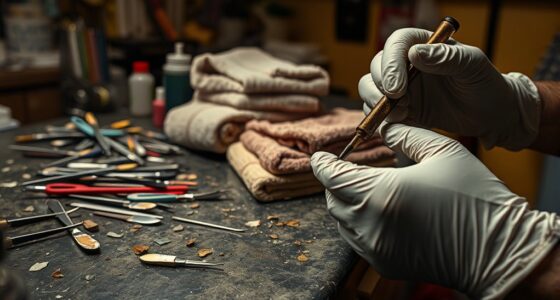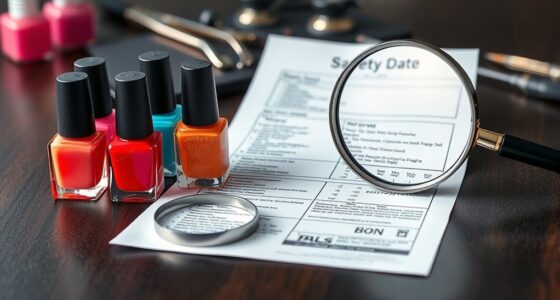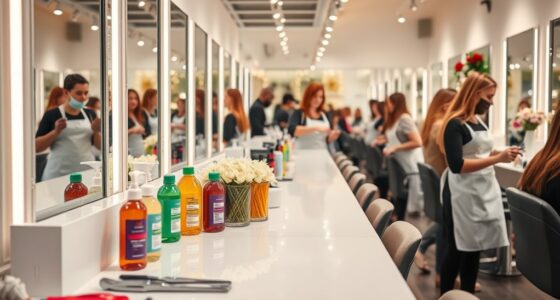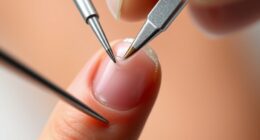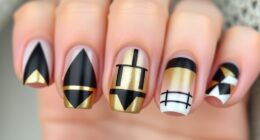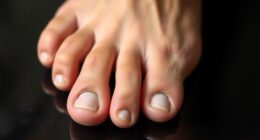Wearing masks, gloves, and goggles is essential for your safety and hygiene as a nail technician. Masks help you avoid inhaling dust and fumes, while gloves protect your skin from chemicals and prevent bacteria transfer. Goggles shield your eyes from splashes and debris, ensuring safety during all procedures. Using this protective gear demonstrates professionalism and keeps your workspace clean. To master proper safety practices and discover essential tips, continue exploring how each piece safeguards your environment and client health.
Key Takeaways
- Masks protect against inhaling dust, powders, and chemical fumes during nail procedures.
- Gloves prevent skin contact with harsh chemicals and reduce cross-contamination risks.
- Goggles or safety glasses shield eyes from splashes, debris, and fumes.
- Proper use of protective gear ensures a safe, hygienic workspace and complies with safety standards.
- Wearing appropriate gear enhances professionalism and builds client trust through cleanliness and safety.

Nail technicians face exposure to chemicals, dust, and potential infections daily, making protective gear essential for safety. When you prioritize wearing masks, gloves, and goggles, you not only protect yourself but also uphold strict sanitation standards that guarantee customer safety. These standards are pivotal in preventing cross-contamination and maintaining a hygienic environment. Proper protective equipment acts as a barrier against airborne particles, chemical fumes, and accidental splashes, reducing the risk of skin irritation, respiratory issues, and infections. Your commitment to safety through the right gear demonstrates professionalism and reassures clients that their health is your top priority.
Protecting yourself with masks, gloves, and goggles ensures safety and upholds sanitation standards vital for client trust.
Wearing masks is especially important because it prevents inhalation of dust from filing, acrylic powders, and chemical vapors from disinfectants and nail products. A well-fitted mask filters out harmful particles and fumes, safeguarding your lungs during long shifts. This not only benefits your health but also aligns with sanitation standards that aim to create a clean, safe workspace. When your clients see you taking these precautions, they feel more confident in your professionalism and dedication to their safety. Masks should be comfortable yet effective, and replacing them regularly ensures they continue to provide proper protection.
Gloves are another essential component of protective gear. They shield your skin from harsh chemicals that can cause dermatitis or allergic reactions. Wearing gloves also helps prevent the transfer of bacteria and fungi from your hands to your clients’ nails, supporting good hygiene practices. It’s important to change gloves frequently, especially after working on each client, to maintain sanitation standards and prevent contamination. Proper glove use reinforces your commitment to customer safety, ensuring that your workspace remains clean and hygienic. Remember, gloves are not a substitute for handwashing; they are an additional layer of protection that complements your overall safety protocol.
Goggles or safety glasses protect your eyes from chemical splashes, dust particles, and accidental tool contact. Eye protection is often overlooked but plays a critical role in preventing injuries and irritation. When you wear goggles, you reduce the risk of exposure to fumes and debris, which can cause discomfort or more serious eye problems over time. Clear, snug-fitting goggles also demonstrate your adherence to safety regulations, reassuring clients that you take every measure to maintain a safe environment. Regularly inspecting and replacing damaged goggles ensures consistent protection, which is essential in upholding sanitation standards and customer safety.
Incorporating masks, gloves, and goggles into your routine isn’t just about compliance—it’s about fostering a safe, professional space for both yourself and your clients. By doing so, you create a spa environment rooted in cleanliness, safety, and trust, which encourages repeat business and sets you apart as a responsible nail technician. Additionally, understanding protective gear benefits helps you make informed decisions to optimize your safety practices.
Frequently Asked Questions
How Often Should Nail Technicians Replace Their Protective Gear?
You should replace your protective gear regularly to maintain proper hygiene protocols. Gear replacement depends on usage; for example, masks and gloves should be changed after each client or if visibly soiled. Reusing gear can spread germs and compromise safety. Always follow manufacturer guidelines and your salon’s policies to guarantee effective protection. Staying consistent with gear replacement helps prevent infections and keeps your workspace safe for both you and your clients.
Are There Eco-Friendly Options for Disposable Protective Equipment?
You’re probably wondering if eco-friendly options exist for disposable protective gear. Yes, there are biodegradable materials made from plant-based fibers and sustainable manufacturing practices that create environmentally friendly protective gear. These options break down more quickly and reduce waste compared to traditional products. By switching to such sustainable gear, you help minimize your environmental impact while maintaining safety standards, making your practice more eco-conscious and responsible.
Can Protective Gear Impact the Precision of Nail Work?
Protective gear can influence your nail detail and precision accuracy. If your equipment fits poorly or feels bulky, it might hinder your steady hand and focus. However, choosing well-designed gear that fits comfortably helps maintain your dexterity. When you wear the right protective gear, it shouldn’t interfere with your work, allowing you to achieve sharp, precise results without sacrificing safety or accuracy.
What Are the Storage Best Practices for Reusable Protective Gear?
You should store reusable protective gear properly to guarantee safety and longevity. Regularly clean your gear based on its usage, ideally after each use, to prevent contamination. Use designated storage containers that are breathable and easy to sanitize, such as mesh bags or labeled bins. Keep the gear in a cool, dry place away from direct sunlight, and ensure it’s fully dry before storing to prevent mold and bacteria growth.
How Do Protective Gear Standards Vary Internationally for Nail Technicians?
You should know that international standards and regional regulations vary for protective gear, affecting nail technicians worldwide. Some countries enforce strict guidelines ensuring gear is latex-free, hypoallergenic, and properly tested, while others have more relaxed rules. To stay compliant, you must understand your local regulations and follow international best practices, ensuring your protective gear provides peak safety and meets the required quality standards, regardless of where you practice.
Conclusion
Wearing the right protective gear isn’t just a good idea—it’s your secret weapon against the invisible villains lurking in every nail salon. With masks, gloves, and goggles, you’re practically invincible, safeguarding yourself from harmful chemicals, airborne particles, and unexpected splashes. Don’t let a tiny mistake turn into a huge health nightmare. Gear up, stay safe, and be the superhero of your own salon—because your health is worth more than a moment’s convenience!



